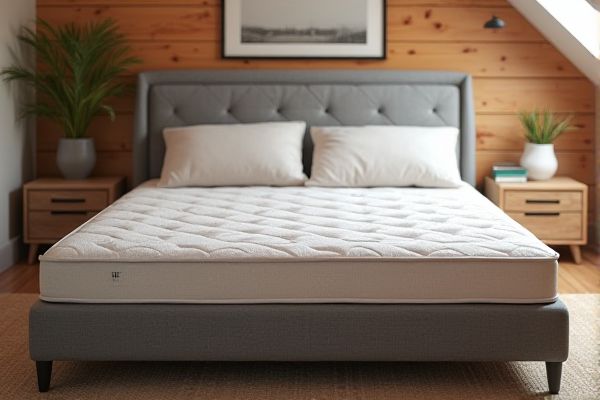
Attic memory foam mattresses offer superior contouring and pressure relief by conforming to your body's shape, while innerspring mattresses provide traditional support with a bouncy feel and enhanced airflow. Discover which mattress type best suits Your sleep preferences and needs by reading the full comparison in this article.
Table of Comparison
| Feature | Attic Memory Foam Mattress | Innerspring Mattress |
|---|---|---|
| Material | Viscoelastic foam | Steel coils with foam or fabric layers |
| Support | Contours to body, pressure relief | Firm, bouncy support with coil system |
| Durability | 7-10 years | 5-8 years |
| Motion Isolation | Excellent - absorbs motion | Poor to moderate - transfers motion |
| Temperature Regulation | May retain heat unless gel-infused | Good airflow through coils |
| Firmness Options | Varies, often medium-firm | Wide range from soft to firm |
| Price Range | Moderate to high | Low to moderate |
| Ideal For | Pressure relief, side sleepers, allergy sufferers | Back and stomach sleepers, those needing firmer support |
Understanding Attic Memory Foam Mattresses
Attic memory foam mattresses offer superior pressure relief and contouring support compared to traditional innerspring mattresses, making them ideal for reducing joint pain and improving sleep quality. Their dense foam layers absorb movement, minimizing disturbances from a restless partner, whereas innerspring mattresses rely on coils that can transfer motion across the bed. Choosing an attic memory foam mattress can enhance your comfort by providing consistent support tailored to your body shape and sleeping position.
What Is an Innerspring Mattress?
An innerspring mattress features a core support system made of metal coils designed to provide firm support and maintain shape over time. The coil count and gauge influence durability and feel, with higher coil counts typically offering better motion isolation and pressure relief. In contrast, an attic memory foam mattress uses viscoelastic foam layers that contour closely to the body, enhancing comfort and reducing pressure points, while providing a different kind of support compared to the bounce and airflow of innerspring coils.
Comfort and Support Comparison
Attic memory foam mattresses provide superior contouring support by evenly distributing body weight, reducing pressure points, and promoting spinal alignment, making them ideal for side and back sleepers. Innerspring mattresses offer firm support with a bouncy feel due to their coil system, which ensures better airflow and durability but may cause pressure buildup on heavier joints. Memory foam excels in minimizing motion transfer and enhancing comfort, while innerspring mattresses often provide better edge support and a cooler sleep experience.
Motion Isolation: Which Mattress Wins?
Memory foam mattresses excel in motion isolation by absorbing and minimizing movement transfer, making them ideal for couples or light sleepers sensitive to disturbances. Innerspring mattresses, with their coil-based construction, tend to transfer motion more noticeably due to interconnected springs. For those prioritizing undisturbed sleep and reduced partner movement, memory foam mattresses typically outperform innerspring models in motion isolation.
Temperature Regulation in Both Mattresses
Attic memory foam mattresses excel in temperature regulation through advanced open-cell technology and gel-infused layers that dissipate heat and enhance airflow. Innerspring mattresses offer superior breathability due to their coil support system, promoting natural air circulation and preventing heat retention. Understanding these temperature management features helps consumers choose the best mattress for maintaining a comfortably cool sleeping environment.
Durability and Lifespan Differences
Attic memory foam mattresses generally offer superior durability due to high-density foam layers that resist sagging and maintain support over time, often lasting 8 to 10 years. Innerspring mattresses tend to have a shorter lifespan, typically around 5 to 7 years, as the metal coils can lose tension and the foam or padding may compress. Your choice depends on the desired longevity and maintenance, with memory foam providing more consistent performance over an extended period.
Noise Levels: Silent or Squeaky?
Attic memory foam mattresses offer a silent sleeping experience due to their dense, noise-absorbing material, making them ideal for minimizing disturbances. In contrast, innerspring mattresses often produce squeaky sounds caused by metal coils moving and rubbing together, which can disrupt your rest. Choosing a memory foam mattress ensures quieter nights and promotes uninterrupted sleep quality.
Budget Considerations and Value
Attic memory foam mattresses typically offer superior pressure relief and motion isolation at a moderate price, appealing to budget-conscious consumers seeking long-term value. Innerspring mattresses generally have a lower upfront cost but may require more frequent replacement due to coil wear and reduced durability. Evaluating the lifespan alongside initial investment highlights memory foam as a cost-effective choice for those prioritizing comfort and longevity.
Sleep Positions: Which Mattress Suits You?
Attic memory foam mattresses contour to your body, providing optimal support for side and back sleepers by relieving pressure points and aligning the spine. Innerspring mattresses offer firmer support and better airflow, making them suitable for stomach sleepers who need a mattress that prevents sinking and promotes spinal alignment. Your sleep position plays a crucial role in choosing between the contouring comfort of memory foam and the structured support of innerspring coils.
Final Verdict: Choosing the Best Mattress for Your Attic
Attic Memory Foam Mattresses offer superior contouring and pressure relief, making them ideal for maximizing comfort in low-ceiling spaces. Innerspring Mattresses provide enhanced breathability and traditional support, which may suit those preferring a bouncier feel or needing better airflow. Selecting the best mattress for your attic depends on balancing comfort preferences, space constraints, and ventilation needs.
 homyna.com
homyna.com